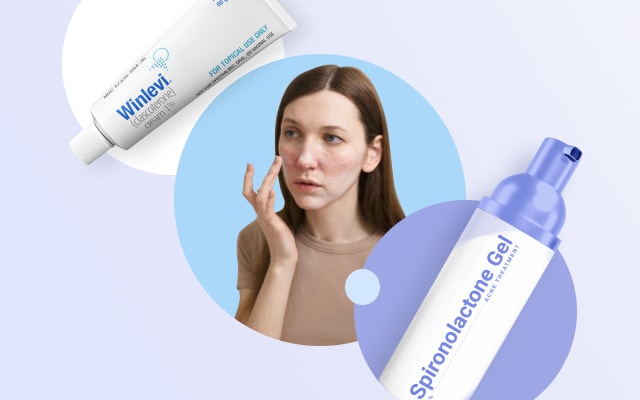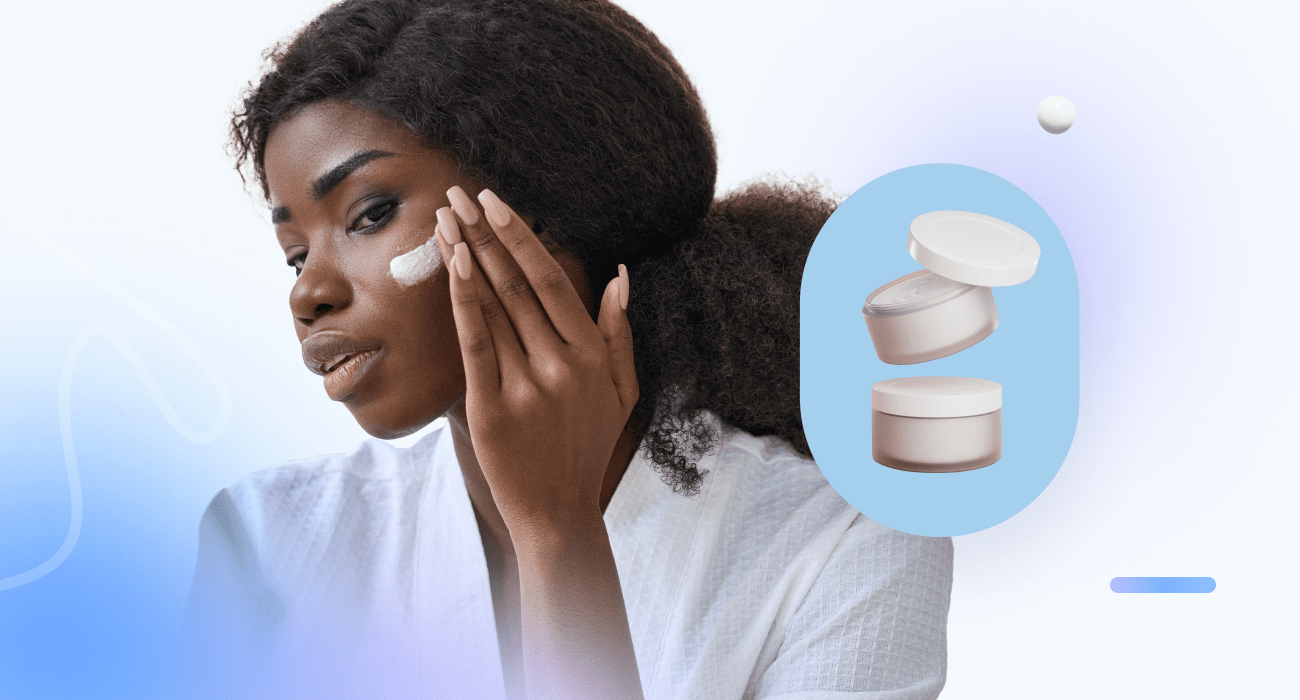How is tretinoin 0.1 % cream different from other strengths?
Dr. Eric Howell, board-certified dermatologist explains how tretinoin cream 0.1% is different from other tretinoin strengths, how to get it and how to properly use it to minimize symptoms.
Table of Content:
How does tretinoin 0.1% improve the skin? | Prescription | Brands | Benefits | How is it different? | Ingredients to use with caution | How to use it? | Side-effects | Precautions
Our commitment to producing high-quality content:
The information presented in this article is based on scientific research and the professional advice of our Content Medical Reviewers, who are experts in the field of Dermatology. How we write our content →
What is tretinoin cream 0.1 used for?
Tretinoin cream 0.1% is a high-strength topical treatment commonly prescribed for managing moderate to severe acne. It works by accelerating skin cell turnover, helping to prevent clogged pores and reduce the formation of acne.
Beyond its acne-fighting properties, tretinoin 0.1% is also used to treat signs of photoaging, such as fine lines, wrinkles, and dark spots caused by prolonged sun exposure. By stimulating collagen production and encouraging the shedding of damaged skin cells, it helps improve skin texture, tone, and overall appearance.
This potent formulation is typically recommended for individuals who need a stronger treatment or who have not responded adequately to lower-strength options. However, due to its strength, careful usage and proper skin care are advised to minimize potential irritation or dryness.
For more details on the expected timeline for results, check out our article How long does it take for tretinoin to work? which draws on Dr. Eric Howell’s clinical experience and practice insights.
How does tretinoin 0.1 cream improve the skin?
- Reduces fine lines and wrinkles
- Repairs sun damage on skin
- Enhances skin texture
- Promotes a more uniform skin tone
- Reduces acne breakouts
Do you need a prescription to buy tretinoin 0.1 cream?
Yes, you need a doctor’s prescription to get tretinoin 0.1% cream which means you should have a consultation with a licensed healthcare professional.
How can you get a prescription for tretinoin 0.1 cream?
To get tretinoin 0.1% cream, you can have a consultation with an online dermatologist through Miiskin. Consultation price is $59 and $39 for the medication renewal (which is usually needed after 3 months.)
Tretinoin 0.1 brands
- Retin-A cream 0.1%
- Retin-A Micro cream 0.1%
What are the benefits of using tretinoin 0.1?
Tretinoin 0.1% has a much higher concentration or potency, this means there is a greater amount of the active ingredient in each application.
Faster results
An increased concentration can potentially provide more significant and faster results in terms of skin improvement, it also means that side effects will be stronger.
More effective
Due to its higher concentration, tretinoin 0.1% may be more effective at addressing various skin concerns, such as acne, fine lines, wrinkles, and hyperpigmentation.
Stronger side effects
While tretinoin 0.1% can deliver enhanced results, it is also associated with a higher likelihood of causing skin irritation, dryness, redness, and sensitivity.
Gradual introduction
Tretinoin 0.1% is typically recommended for individuals who have already used and gotten used to lower-strength tretinoin products.
How is tretinoin 0.1 cream different from other tretinoin strengths?
Tretinoin 0.1% cream differs from other tretinoin strengths primarily in its potency, with each strength offering varying levels of effectiveness and potential side effects. Here’s how they compare:
- Tretinoin 0.025%: This is the lowest concentration, typically prescribed for individuals with sensitive skin or those new to retinoid therapy. It has a gentler effect on the skin, making it suitable for mild acne, fine lines, and hyperpigmentation. It’s a good starting point for those with minimal skin concerns or those who are prone to irritation.
- Tretinoin 0.05%: This medium-strength concentration is commonly used to treat moderate acne and photoaging. It provides more noticeable results in improving skin texture and reducing fine lines, dark spots, and wrinkles. It is often prescribed for patients who have built tolerance to lower concentrations and are seeking stronger effects without the higher risk of irritation that comes with 0.1%.
- Tretinoin 0.1%: The highest concentration, tretinoin 0.1% is typically reserved for more severe acne, significant signs of photoaging, or for patients who have developed tolerance to lower strengths. This formulation is much more potent, offering faster and more dramatic improvements in skin renewal but also carries a higher risk of side effects, such as dryness, redness, and irritation.
In general, the higher the concentration, the more effective it may be for tougher skin concerns, but it also requires a more cautious approach to avoid potential irritation. Dermatologists often start patients on lower strengths and gradually increase the concentration as the skin builds tolerance.
What ingredients should be used with caution when also using tretinoin 0.1?
As a general rule when you are getting your skin used to tretinoin 0.1% you should keep your skin care routine as simple as possible and only use gentle ingredients with this tretinoin strength. Once your skin is used to it you can slowly introduce other ingredients very slowly. Skip application of tretinoin and other active ingredients if your skin becomes too irritated. Instead, apply a hyaluronic acid or ceramides serum during that night.
- Hydroquinone: While hydroquinone is considered the golden standard to treat hyperpigmentation alongside tretinoin, this combination and tretinoin strength can cause additional irritation, therefore it should be introduced gradually if used together.
- Salicylic, lactic or glycolic acid: These ingredients will increase skin sensitivity and irritation when combined with tretinoin 0.1%. In the beginning do not used them together, once your skin has adjusted to tretinoin 0.1% use them on alternate days.
- Benzoyl peroxide: While tretinoin and benzoyl peroxide are both effective acne treatments, if both are prescribed, use them on different days as they will cause too much irritation together.
- Vitamin C: although this antioxidant that can brighten the skin, boost collagen production and reduce hyperpigmentation, it can cause irritation when used alongside tretinoin 0.1%. Only use in the morning, when your face has adjusted to tretinoin and do not use it along side the other ingredients mentioned above. Keep your skin care routine simple.
How to use tretinoin 0.1?
Preparation
- Wash your face with a gentle cleanser and warm water. Avoid using cleansers with benzoyl peroxide, glycolic or salicylic acid before applying tretinoin.
- Pat your skin dry with a soft towel. Make sure your skin is completely dry (wait at least 20-30 minutes) before applying tretinoin, as applying it to damp skin can increase irritation.
Application
- Apply a gentle, non-comedogenic moisturizer to help prevent irritation.
- Use a pea-sized amount of the cream only as tretinoin 0.1% is very potent.
- Dab small amounts onto your forehead, cheeks, chin, and nose and spread the cream over your entire face.
- Avoid the areas around the eyes, lips, and corners of your nose.
- Do not apply to areas with broken skin or open wounds or these sensitive areas.
Post-application
- Wash your hands after applying the cream to avoid spreading cream into other areas of your face or into your eyes.
- Apply a hyaluronic acid, niacinamide or a ceramides serum to soothe your skin.
Frequency of use
- In the beginning, use tretinoin 0.1%, 2-3 times per week to allow your skin to adjust and gradually increase frequency of use to every other night use as your skin builds tolerance.
- In most cases, tretinoin might be too strong for nightly use.
- If you experience significant irritation, redness, or peeling, skip application for 1 or 2 days and resume application when your skin has recovered.
Sun protection
- Tretinoin makes your skin more sensitive to sunlight. Use sunscreen every day (even on the days you don’t apply tretinoin) with SPF 50 daily and consider wearing a wide-brimmed hat and seek the shade.
Consistency
- Consistent use is key to experience visible results.
- Using more than recommended will not speed up results and may increase the risk of irritation.
Consult your dermatologist
By following these steps, you can use tretinoin cream 0.1% effectively and safely. Regular check-ins with your dermatologist are important to monitor your skin’s progress and make adjustments to your regimen as needed.
Potential side effects of tretinoin 0.1
Even if you’ve been using tretinoin for a while, transitioning to a higher strength can still trigger side effects like dryness and peeling, especially in the first few weeks. This period, often referred to as the “tretinoin purge,” occurs when the skin accelerates its cell turnover, leading to a temporary worsening of acne and increased irritation. During this time, you may experience common side effects such as:
- Skin irritation
- Dryness
- Heightened sensitivity to sunlight
- Temporary worsening of acne (the purge)
- Increased skin sensitivity
- Redness
- Peeling
- Stinging or burning sensation
While these side effects are common, they typically subside as your skin adjusts to the higher concentration of tretinoin.
Precautions
Tretinoin is classified as a teratogen, meaning it poses serious risks to a developing fetus. As a result, it should not be used by women who are pregnant, planning to become pregnant, or breastfeeding
Women using tretinoin creams or gels, including concentrations of 0.1% or lower, are strongly advised to use effective contraception during treatment.
This medication should only be used under the guidance and supervision of a dermatologist.
Provider & Prescription Information
Miiskin connects patients with independent dermatologists who provide care through their own private practices. Miiskin does not employ dermatologists and does not sell or distribute medications. Any prescriptions issued by the dermatologists can be filled at third-party pharmacies that are able to receive ePrescriptions.
References:
1https://www.ncbi.nlm.nih.gov/books/NBK557478/
2https://www.ncbi.nlm.nih.gov/pmc/articles/PMC9112391/
3https://link.springer.com/article/10.2165/00002512-199506060-00008
4https://www.ncbi.nlm.nih.gov/pmc/articles/PMC3225141/
5https://pubmed.ncbi.nlm.nih.gov/16045694/
6https://www.ncbi.nlm.nih.gov/pmc/articles/PMC3225141/
7https://www.ncbi.nlm.nih.gov/pmc/articles/PMC9112391/
https://www.ncbi.nlm.nih.gov/books/NBK539693/
https://www.ncbi.nlm.nih.gov/pmc/articles/PMC5605218/
https://pubmed.ncbi.nlm.nih.gov/12553851/
https://www.ncbi.nlm.nih.gov/pmc/articles/PMC6981886/
https://www.ncbi.nlm.nih.gov/pmc/articles/PMC6253993/






 Interested in getting a tretinoin 0.1% prescription?
Interested in getting a tretinoin 0.1% prescription?